Jealousy: Modern Architecture and Flight
The airplane and the modern conscience of urbanism
Eric Bunge
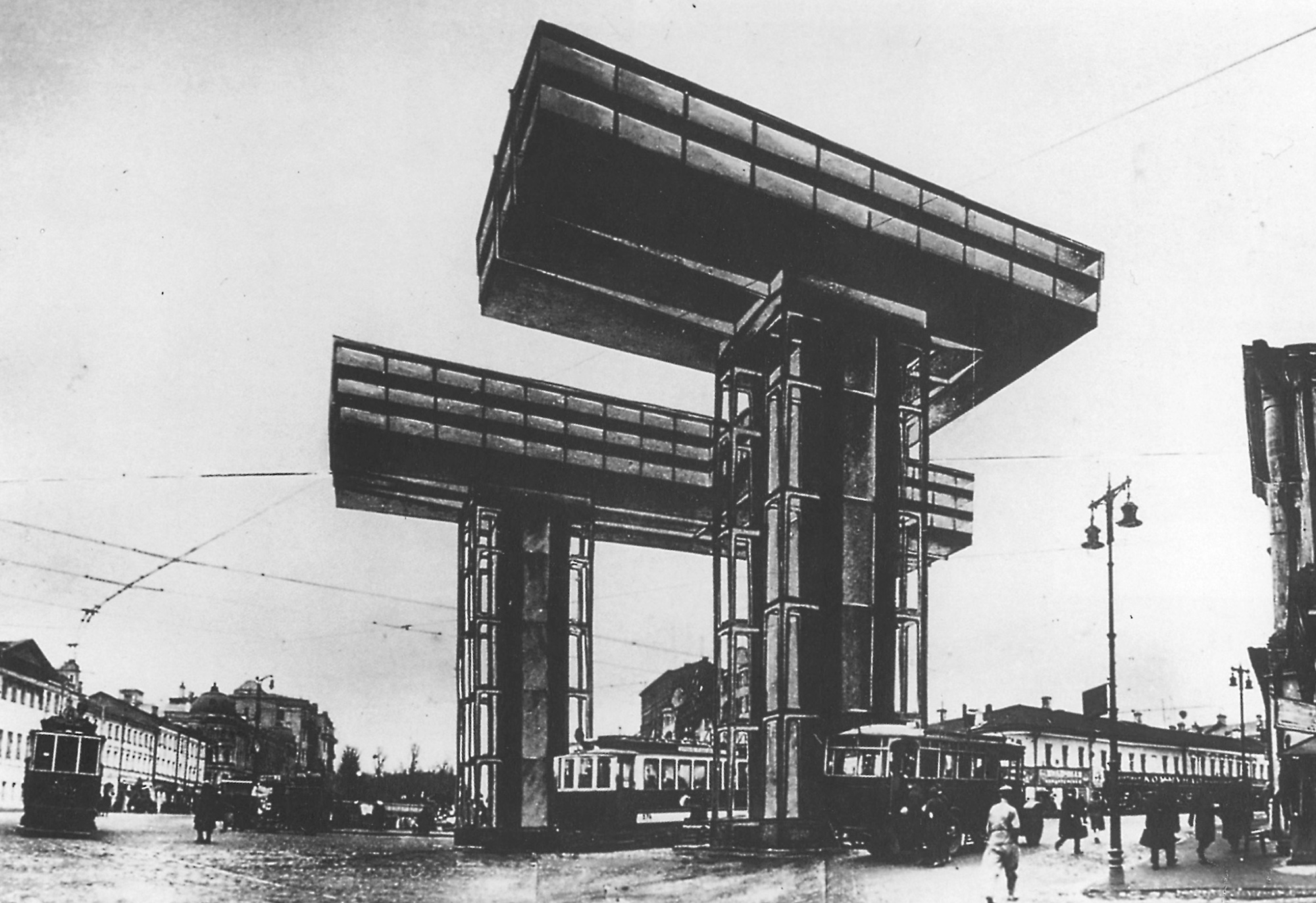
Two years before the bombing of Guernica, Le Corbusier famously described the airplane as an optical device:
The airplane indicts the city. ... By means of the airplane, we now have proof, recorded on the photographic plate, of the rightness of our desire to alter methods of architecture and city planning. With its eagle eye the airplane looks at the city. ... The airplane instills, above all, a new conscience, the modern conscience. Cities, with their misery, must be torn down. They must be largely destroyed and fresh cities rebuilt.[1]Guernica fulfilled the first half of this chilling desire. For Le Corbusier, however, the airplane promised both destructive and constructive potential—the “eagle eye” that also instills a “modern conscience.” While looking out another airplane window on a South American journey in 1927, he sketched an urban design for Rio de Janeiro, a project arguably influenced by this vantage point.[2] The airplane therefore produced a sort of two-way vision. Newly airborne modern architects looked down at architecture from airplanes, while also looking up at the new technology for inspiration, jealously seeing in powered flight some of the anti-gravitational aspirations of Modern architecture itself. In a sense, the unprecedented weightlessness of these early flying observers paralleled their desire to liberate their medium from the ground as well.
At a time when associations between architecture and flight have been eclipsed by a single image of collision, it is difficult to recall the degree to which their correlation was instrumental in generating the central tenets of modern architecture. Many of its themes and motifs—liberation of the ground plane, emphasis on the horizontal, and the use of cantilevers and pilotis, to name a few—coincided with the advent of powered flight and the obsession with weightlessness that it provoked. Within a few years of the Wright brothers’ success in 1903, Kasimir Malevich proposed a new Suprematist anti-gravitational architecture; Aleksandr Rodchenko introduced the notion of the “top elevation” or use of a building’s roof as an aerial façade; El Lissitzky proclaimed the need for “vertical zoning”; and architects throughout Europe and the Soviet Union began designing raised, floating, cantilevered, and even flying buildings. Although larger cultural forces were certainly at play in defining the political, technological, and aesthetic ideals of modernism, the work and subsequent influence of these polemical artists and architects suggest that new perspectives afforded by flight contributed in some measure to the development of design strategies now considered to be hallmarks of modern architecture.
The theme of weightlessness in architecture undeniably predated powered flight. Hitherto, opposing spatial perspectives had been made familiar by paintings depicting floating cities seen from below, and by a long lineage of aerial views. The latter ranged from the Renaissance fantasy Veduta di Venezia (c. 1500), by Jacopo de’ Barbari, to the photos taken from a balloon by Nadar in the 1850s. As Michel de Certeau wrote, “The desire to see the city preceded means of satisfying it. Medieval or Renaissance painters represented the city as seen in a perspective that no eye had yet enjoyed.”[3] While these images had inspired an aerial imagination, the aerial perspective had not yet entered significantly into architectural discourse.
Soon after the turn of the century, however, the aerial view began to affect modes of vision, and consequently, architectural production. During World War I, the map-like flatness seen from windows of reconnaissance airplanes gained in strategic value over the perspectival space surveilled by ground patrols. Concurrently with this rotation in operative visual modes, Suprematist, Cubist, and Italian Futurist painters began rejecting the horizon, familiar spatial reference, and gravity. Their collective body of work played an important role in articulating new spatial agendas to architects, apparent in a generalized tendency towards abstraction; a horizontal and vertical displacement of volumes; the reversal of gravity by positioning the visually heavy above the apparently light; and a constantly changing composition of objects, predicated on an unstable, three-dimensionally mobile observer. Malevich’s Suprematist compositions, for example, depicted proto-architectural geometric elements floating on white backgrounds and suggesting a weightlessness of both medium and viewer. (He famously extended the gravitational logic internal to the canvas into the space of the gallery by hanging his paintings so that they appeared to float at a distance from the walls.) Malevich believed that weightlessness constituted the highest aim of technology, and hoped that scientific advances would make free unpowered flight feasible, allowing cities to be placed as satellites floating in the cosmos. In the early 1920s, he explored these themes in his paintings of Aero-Cities, which were linked to the Planite dwellings for earthlings. Lissitzky quickly reformulated Maleveich’s hovering Planites as a formal vocabulary in his Prounen (“Projects for the Affirmation of the New”), painted between 1919 and 1921. Unlike the layered, two-dimensional planes of the Suprematist paintings, the Prounen depicted three-dimensional, axonometric volumes, many of them also floating in space. Lissitzky described them as “the station where you transit from painting to architecture,”[4] and indeed, in the next two decades, the Planites and the Prounen served as a sort of genetic code for architecture and its changing relationship to the ground.
The liberation of buildings from the ground plane became a recurring theme for 20th-century architects intent on realizing dreams of weightlessness. As with the canonical example of Le Corbusier’s Villa Savoye (1929–1931), their preoccupation with levitation emerged alongside various philosophical developments, ranging from a belief that the ground plane should be reserved for communal use and vehicular circulation, to developing notions of space. The concept of space—a term with multiple and transient meanings—had only been adopted into architectural discourse as late as the end of the 19th century, and was intimately linked to the development of Modernism itself. During the first two decades of the 20th century, the term had been used mostly in the sense introduced by the architect and theorist Gottfried Semper, of space as enclosure.[5] But in the 1920s, the Dutch group De Stijl, among others, argued instead for a radical notion of space as continuum, an idea which held that space, inside and outside, was uninterrupted and infinite. In its challenge to the role of enclosure in creating space, this notion resulted in a desire for unbounded freedom and weightlessness. Modern architects would only partially satisfy this desire, seemingly levitating “ground” floors above the ground through the use of slender pilotis, expansive sheets of plate glass in place of walls, and flooring materials that were continuous from interior to exterior. As the Viennese architect Frederick Kiesler wrote in a De Stijl manifesto describing his “City in Space” installation at the Paris Exhibition of Decorative Arts in 1925: “Walls, walls, walls ... we want: A system of tension in free space. A change of space into urbanism. No foundation, no walls. Detachment from the earth, suppression of the static axis. In creating new possibilities for living, a new society is created.”[6] Forty years later, images of massive, democratic crowds—uncircumscribed by walls—underneath the hovering plinth of Lina Bo Bardi’s Sao Paolo Museum (1957–1968) testified to these ideas about space as a continuum.
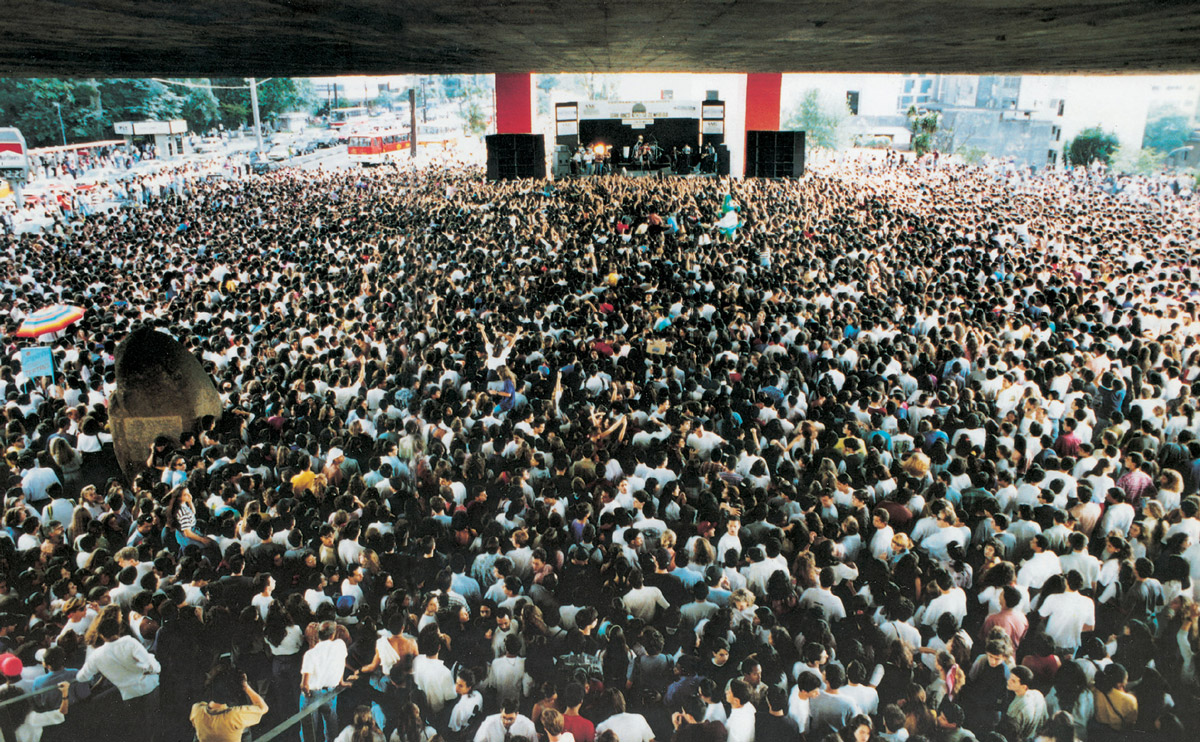
While this idea was reshaping European architecture’s relationship to its foundations, utopian architects in the Soviet Union were imagining buildings and cities that would literally fly—as well as sites intended for a soaring public. One year before the Villa Savoye, Georgy Krutikov designed his radical 1928 Flying City, drawings of which were widely publicized. A student of the Soviet Rationalist Nikolai Ladovsky at Vkhutein (previously Vkhutemas, the influential school of architecture in Moscow), Krutikov pursued his visionary experiments in the context of a decade-long debate about town planning. Much effort was made to conceive of new solutions for dwelling communes that could reconcile inequalities between urban and rural areas, and therefore to a certain extent between buildings and the ground. Thus, in an effort to minimize the impact of cities on the environment, dwellings and official buildings in Flying City would drift above the earth, powered by atomic energy. Inhabitants would travel in individual cabins between the city and the terrestrial surface, which would be reserved for labor and leisure. These universal vehicles of transport, when not plugged into dwelling units, would function as short-range mobile homes, fitted with retractable furniture. Almost a decade earlier, in 1920, Rodchenko had designed a hypothetical new town also predicated on an aerially mobile populace. He envisioned buildings shaped as upside-down pyramids, their roofs providing a new top tier to be viewed by air travelers. Rodchenko went so far as to proclaim that this “top elevation” or fifth facade would in the future become the principal object of admiration, and that all architectural and artistic activity should be concentrated on it, leaving the surface of the earth for rudimentary facilities. His proposed town, therefore, both established a new, elevated ground surface and imagined viewers elevated still higher, independently airborne and able to look down on floating rooftops.
Utopian designs like Krutikov’s and Rodchenko’s, which responded directly to the planned nature of the Soviet economy and the abolition of private ownership of land, served as an architectural laboratory in which pressing practical problems were extrapolated to produce radical architectural proposals. And this radicality, in turn, was emblematic of a search—however quixotic—for a truly buildable weightless architecture. As Lissitzky wrote in a chapter titled “The Future and Utopia” in his 1930 book Russia: An Architecture for World Revolution:
One of our utopian ideas is the desire to overcome the limitations of the substructure, the earthbound. ... [This idea] can be extended even further and calls for the conquest of gravity as such. It demands floating structures, a physical-dynamic architecture. ... Though in reality a reduction of these futuristic plans and proposals is still necessary, their basic soundness is apparent even at the present time.
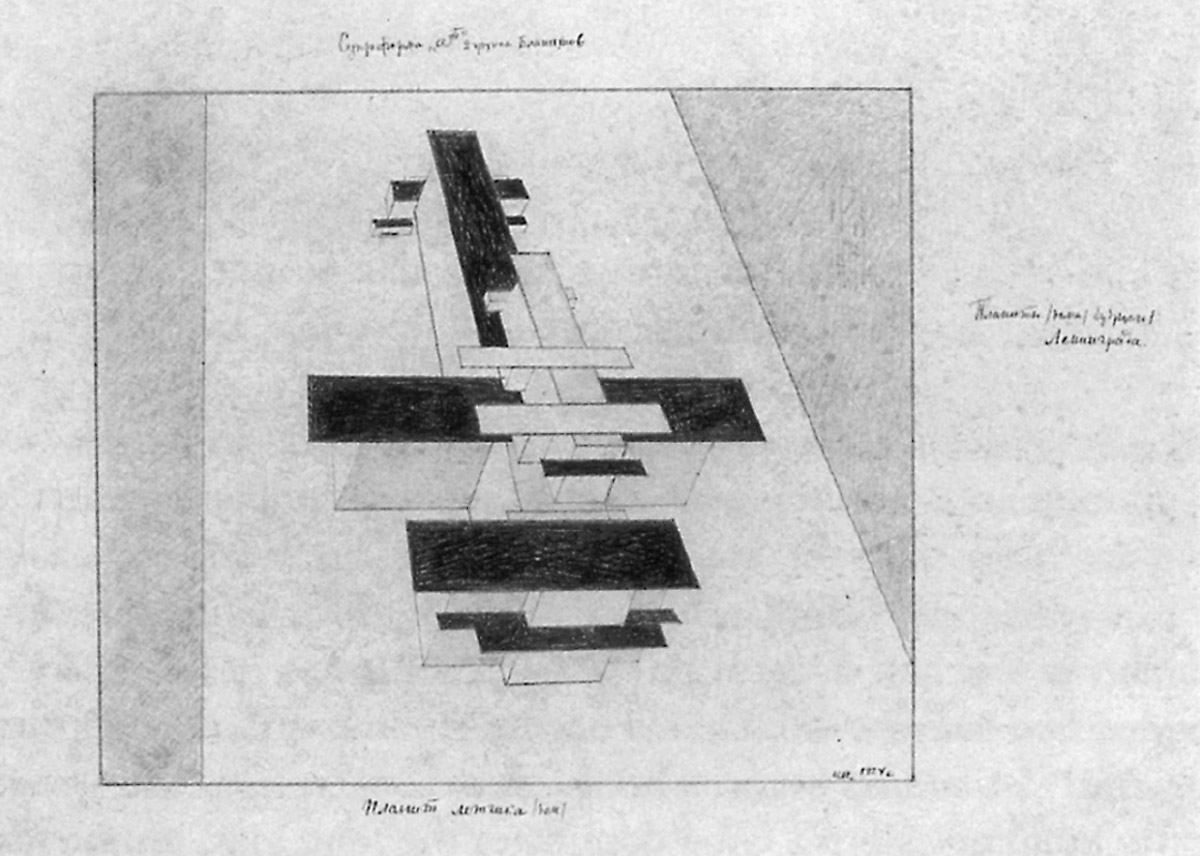
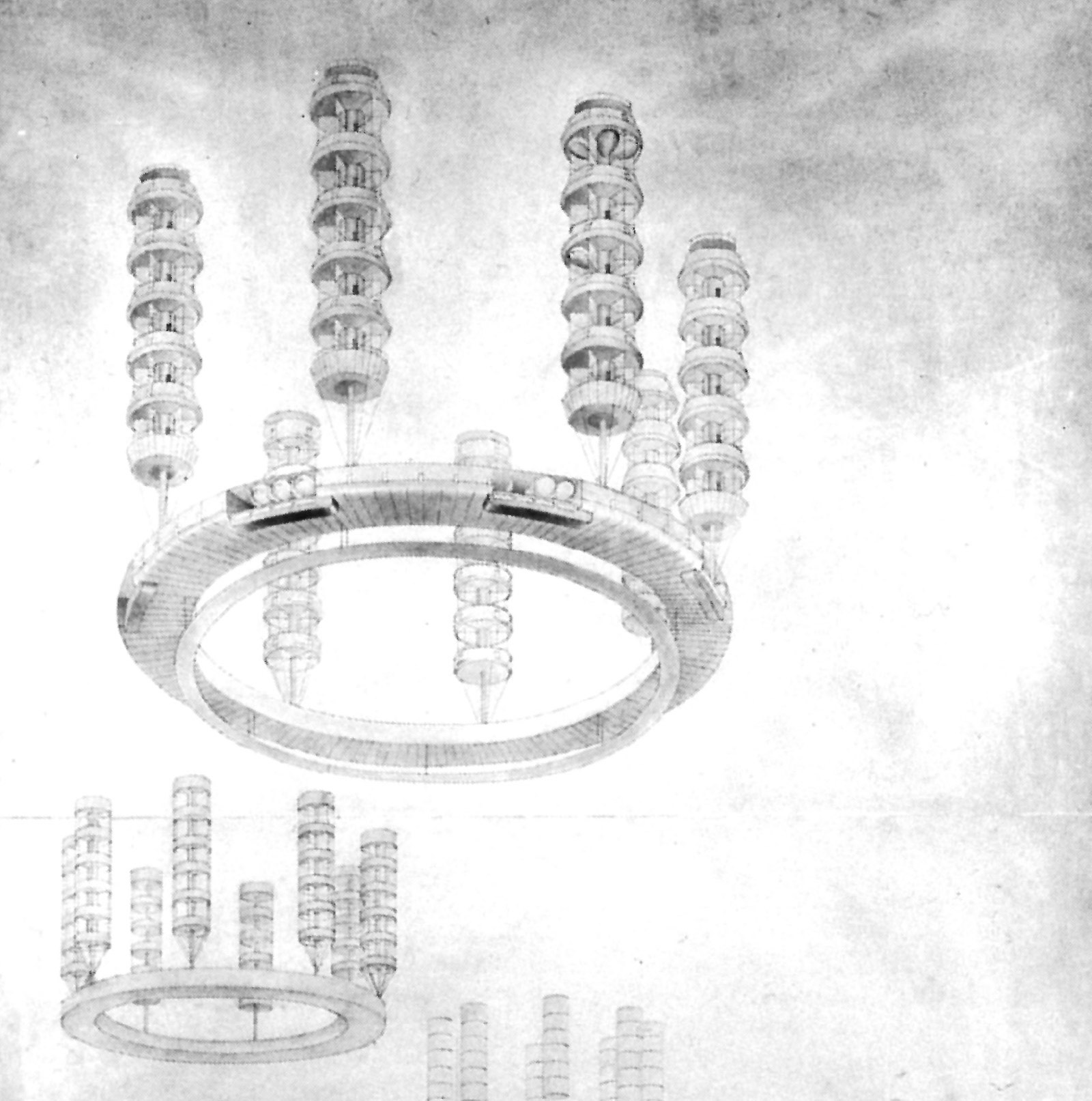
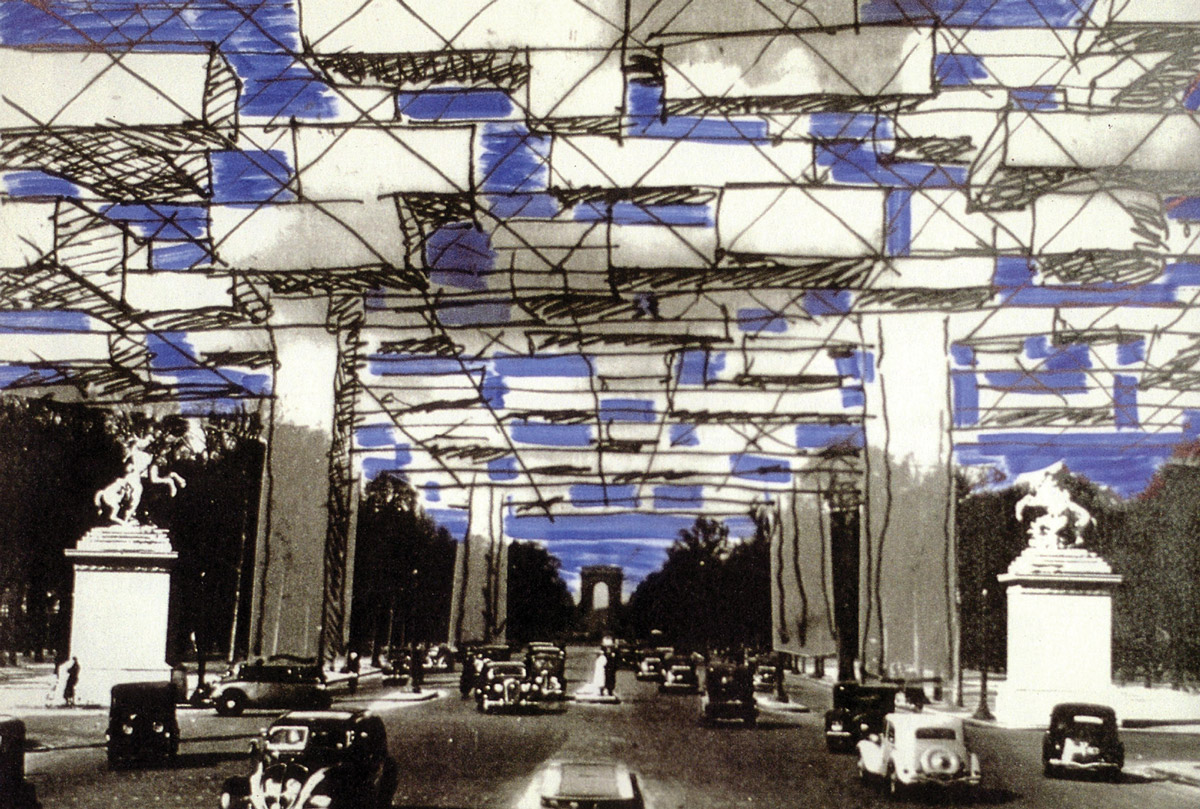
As an architect with ties to the Rationalist architecture of Ladovsky’s ASNOVA group and the Bauhaus school in Dessau, Lissitzky strove for a balance between pure research and technically feasible design solutions. His Sky Hook project (1923–1925), therefore, was both socially utopian and in theory structurally viable, superimposing the “demands of the new times” over the old Moscow fabric. Also called Horizontal Skyscrapers, the project proposed a ninety-degree rotation of the American archetype. Eight identical office buildings, consisting of massive horizontal volumes supported by slender vertical pillars housing stairs and elevators, would cantilever over major traffic intersections. The result was an unstable equilibrium designed to produce an effect of weightlessness. Sky Hook was also generated by a logic of transportation at both functional and perceptual levels. Lissitzky imagined that people and goods arriving at the buildings by metro would be directly uploaded via elevator and then redistributed horizontally, bypassing the ground level and alleviating traffic congestion. As such, the buildings would function as aerial extensions of public infrastructures like the metro. At the same time, like Rodchenko, Lissitzky rejected the notion of a unitary facade, demanding that his buildings be viewed from mobile viewpoints, including from above. During the next five decades, avant-garde architects designed countless fictional cities and buildings predicated on similar levitations of the ground plane and the new perspectives this aerial strategy produced. In spite of its apparent efficiency, however, vertical zoning—as this strategy came to be known—remained largely untested.
Whereas World War II catalyzed the suburbanization of an unscathed postwar America, European architects, confronted with enormous tasks of urban reconstruction, began considering the urbanization of airspace above their destroyed 19th-century cities. Earlier tabula rasa proposals for new cities, such as Le Corbusier’s 1925 Plan Voisin for Paris,[7] were increasingly replaced by proposals reminiscent of Sky Hook, which duplicated rather than erased the ground. Instead of schemes that would raze the city, these designs proposed to selectively build new layers on top of it. Theoretical work on vertical zoning reached its apex in the projects of the Israeli architect Yona Friedman and the Dutch artist Constant Nieuwenhuys in the late 1950s and 1960s. Characterized by a spatial de-lamination of basic urban elements—buildings, public space, traffic, and pedestrian paths—their architecture continued to celebrate vertical zoning for its promise of efficient land use and flexibility. Friedman’s Ville Spatiale of 1958, and Paris Spatiale of 1959, for example, responded to housing shortages in France with massive steel frameworks of services raised 15–20 meters above the ground. Within these neutral infrastructures would be installed adaptive “hardware”: mobile elements such as walls, floors, and appliances for individual dwellings. By separating dwellings from a continuous urban space below, Friedman envisaged an endlessly flexible public ground interrupted by a minimum surface-area of supports.[8] The macro structures or “sectors” of Constant’s New Babylon (1957–1974) proffered a similar set of specifications: also horizontal and supported 15–20 meters from the ground, each “sector” housed a moveable interior structure, programmable to create variable ambiences. As with Spatial City, the primary objective of New Babylon was to produce environments for leisure and play—the primary modus operandi of the Situationist International, of which Constant was a founding member.[9] Like the works of other architects of their generation, Constant’s and Friedman’s projects entailed a wish for flexibility that, aligned with the Situationist practice of détournement, resulted in more than the willful mis-appropriation of urban space. Their projects invariably—and illogically—experimented with a duplication of the ground surface, a focus perhaps indicative of a separate interest in the dematerialization of earth-bound architecture.

Through all these experiments, the Modernist search for material and perceptual lightness in architecture returned continually to the airplane as an idealized model of efficiency. Le Corbusier’s oft-quoted maxim—“The house is a machine for living in”— is immediately preceded in the original text by a reference to the design process by which powered flight was achieved: “The lesson of the airplane lies in the logic which governed the statement of the problem and its realization.”[10] First appearing in a chapter titled “Airplanes” in his seminal book, Towards a New Architecture (1923), these phrases refer to both the product and the process, admonishing architects to design efficient buildings efficiently. One who heeded this challenge repeatedly over the course of his long career was the American autodidact, architect, engineer, and humanist Buckminster Fuller. His oeuvre includes a series of projects in which the aerial vehicle serves not only as a model, but—as in the case of the Dymaxion House (1927)—as a construction tool as well:
I gave myself the problem in 1927 of delivering a ten-deck apartment building to the North Pole, during the arctic summer ... I found I could make a ten-deck building so light that it could be carried by the Graf Zeppelin, suspended horizontally under the Zeppelin’s belly. The Graf, upon reaching the arctic site, could drop a bomb, make a crater, lower the building into the crater, plant it like a tree, and fly back home.[11]A generation later, while he was the head engineer on the Board of Economic Warfare (1941-46), Fuller had the opportunity to realize his lifetime dream of light construction on a hitherto unprecedented scale. The Wichita Dwelling Machine, a further development of the Dymaxion House, was to be entirely fabricated by the Beech Aircraft factory in Wichita, Kansas, and mass-produced for an expected boom in postwar housing. The cylindrical structure used materials and construction methods from the aviation industry to produce a cost-effective and portable dwelling. But although Fuller received 30,000 expressions of interest from all over the country, only two full-scale prototypes were ever produced. The rapid development of the Cold War prevented the retooling of the armaments industry for civilian uses, and Beech Aircraft ultimately decided not to make the investment required to achieve serial production. After the war, Fuller devoted much of the rest of his life to the design and construction of geodesic domes. The most famous of these was the American Pavilion at the Montreal Expo of 1967, while the most ambitious was certainly the hypothetical 1962 project Cloud Structures. Fuller proposed spherical geodesic structures measuring 1.5 miles in diameter that would float through the air, carrying thousands of inhabitants. In spite of its awesome scale, Fuller believed in the technical feasibility of the project, reasoning that the larger the geodesic dome, the lighter its structure would be in comparison to the air it contained. The trapped air, when heated by the sun, would escape, thereby propelling the Cloud Structures through the air in a re-naturalizing of airplane flight.
Like the utopian Soviet projects of the 1920s, Fuller’s paragons of weightlessness have yet to materialize. As pure research, however, they— like so many of the projects that preceded them—participate in the larger philosophical discourse about architecture’s relationship to the ground. Throughout the period that historian Eric Hobsbawm has called “the short twentieth century,” the opposing perspectives facilitated by flight—earthbound, looking up, and airborne, looking down—have helped to shape the aspirations of Modern architecture. In addition to the proliferation of perceptual modes produced by the weightless medium of virtual reality—fly-through animation being a case in point—another way in which this discourse continues to develop may be observed in the increasing absorption of architecture by the larger discipline of landscape architecture. Armed with tools that had become inadequate for solving problems of complexity and large scale, architects in the 1970s began to appropriate landscape architecture’s strategies and discursive fields. A search for weightlessness and a suspicion of architecture’s submissive relationship to the earth’s surface paradoxically contributed to a return to earth: the Modernist obsession with the liberation of architecture from the ground plane evolved into a preoccupation with a liberation of the ground plane itself. No longer perceived as a necessary datum for a gravity-based architecture, the ground became another subject of manipulation, as illustrated by myriad architectural projects involving folded, stacked, and warped roofs and floors, camouflaged to be interpreted as ground-planes. This tendency—exemplified in the American architect James Wines’s (of SITE) Best Parking Lot of 1976, and prevalent at the turn of the 21st century in projects such as the Dutch firm MVRDV’s Dutch Pavilion for EXPO 2000 in Hannover—can be seen as a natural extension of early 20th-century spatial paradigms that destabilized the oppositional logics of building/ground, inside/outside, and dwelling/habitat. But this new interest in landscape also testifies to the continued predominance of an optical mode introduced by flight and sustained by now-ubiquitous satellite views of the earth. For Le Corbusier, “the airplane mobilized invention, intelligence and daring: imagination and cold reason.... the same spirit that built the Parthenon.”[12] Today, aerial vision has gained currency as a perspective of control and attack, and the airplane is perceived by architects above all as a weapon, renewing a scrutiny of architecture’s capacity to defend both the autonomy of its discourse and the resistance of its products to collision.[13] Nevertheless, after a short century of jealousy, many of architecture’s aspirations to flight remain intact.

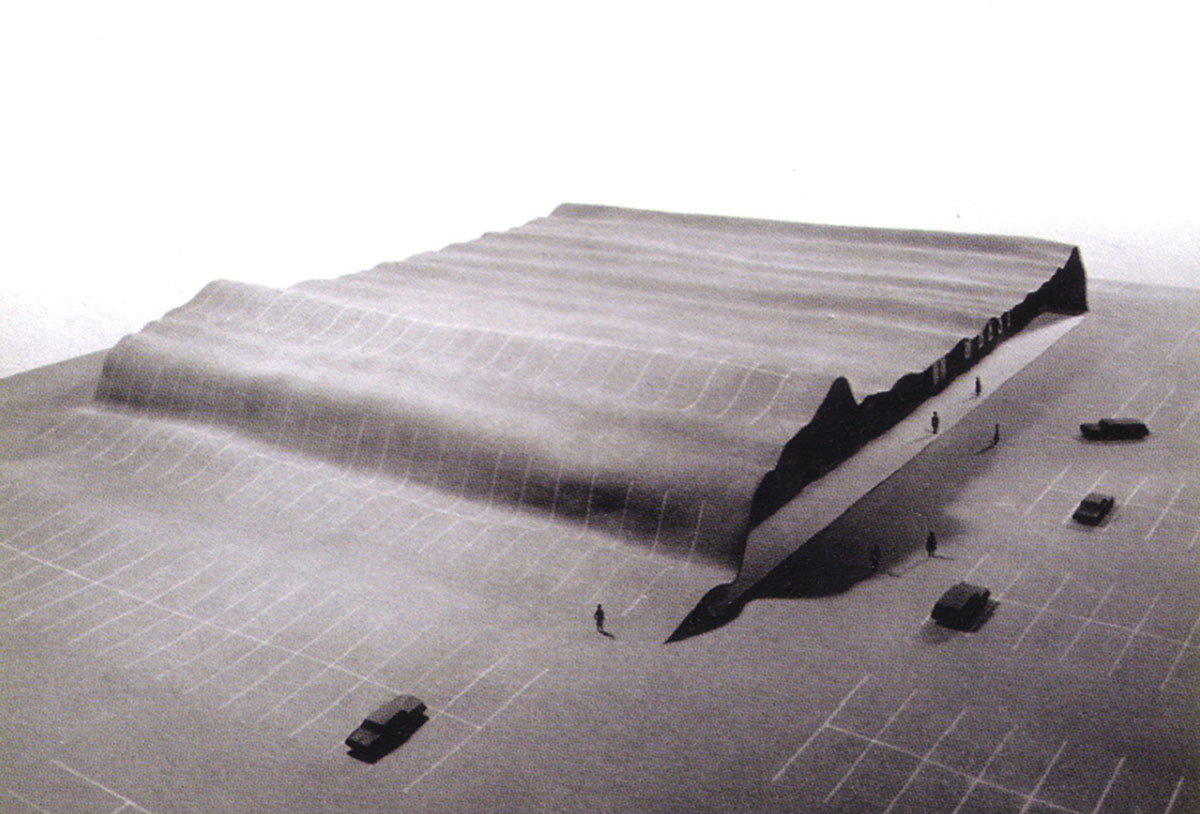
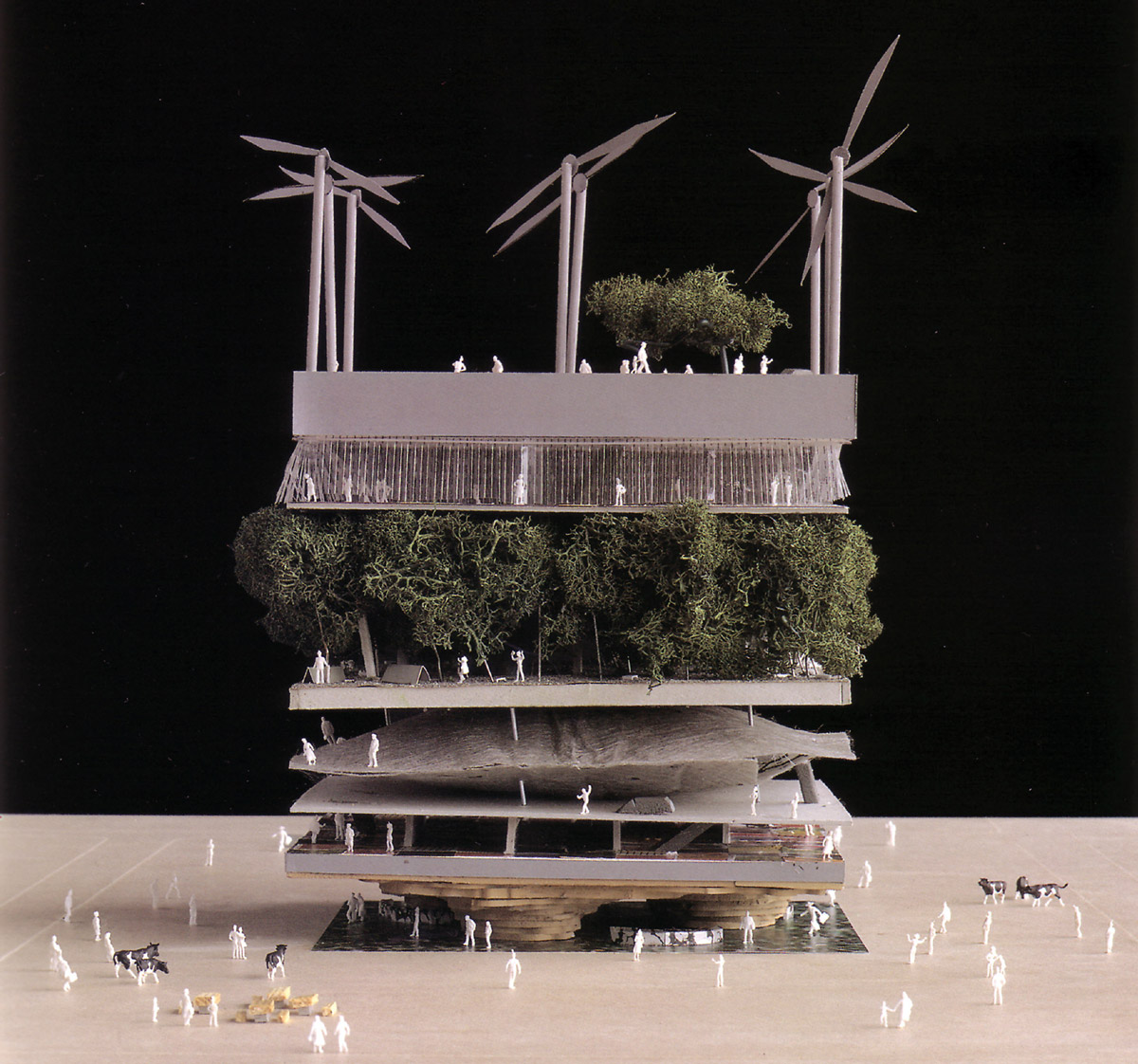
- Le Corbusier, Aircraft (London: The Studio Ltd., 1935), pp. 11–12.
- See Adnan Morshed’s “The Cultural Politics of Aerial Vision: Le Corbusier in Brazil (1929),” Journal of Architectural Education, vol. 55, no. 4 (2002).
- Michel de Certeau, “Walking in the City,” in The Practice of Everyday Life (Berkeley: University of California Press, 1988), p. 92.
- Selim O. Khan-Magomedov, Pioneers of Soviet Architecture (New York: Rizzoli, 1987), p. 63.
- This notion was then further elaborated by Peter Behrens and Adolf Loos ( Raumplan). For more on the history of the adoption into architectural discourse of terms such as “space,” see Adrian Forty’s Words and Buildings (London: Thames & Hudson, 2000).
- De Stijl, no. VII., quoted in Forty, Words and Buildings, p. 266.
- A project that, along with his earlier City of 3,000,000 Inhabitants (1922), is now considered the primogenitor of the “Tower-in-the-Park” scheme, Plan Voisin would have replaced large swaths of Paris with a grid of towers.
- As an alternative to suburbanization, Friedman proposed to urbanize airspace: “The essence of the plan was to recuperate usable airspace above existing buildings in all districts where they were feasible, without interfering in any way with the use of those levels underneath the structure.” Friedman quoted in Sabine Lebesque and Helene Fentener van Vlissingen, eds., Yona Friedman: Structure Serving the Unpredictable (Rotterdam: NAi Publishers, 1999), p. 34.
- Constant was expelled from the Situationist International in 1960.
- Le Corbusier, “Airplanes,” in Towards a New Architecture [1923], (London: Dover Publications, 1986), p.100.
- Joachim Krausse and Claude Lichtenstein, eds., Your Private Sky: R. Buckminster Fuller, The Art of Design Science (Zurich: Lars Müller Publishers, 1999), p. 103.
- Le Corbusier, Towards A New Architecture, p. 101.
- Spurred by a paranoia about collapse, architects competing for the rebuilding of the World Trade Center in 2002–2003 responded by designing various modifications to otherwise normative skyscrapers, including horizontal escape routes between buildings, empty structural skeletons or telecommunications towers replacing office space at upper levels, and various technical improvements to elevators and structural systems.
Eric Bunge is a principal of the New York–based firm nARCHITECTS, and teaches architecture design studios at Parsons School of Design, and at Barnard & Columbia Colleges. Bunge is a contributing editor at Cabinet.